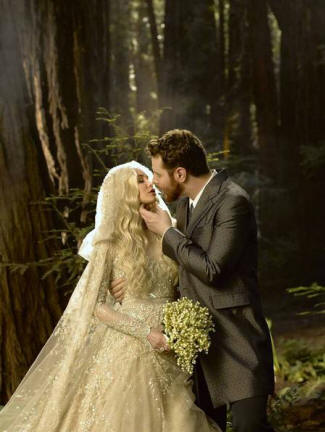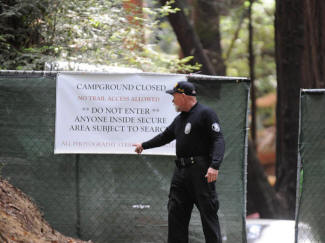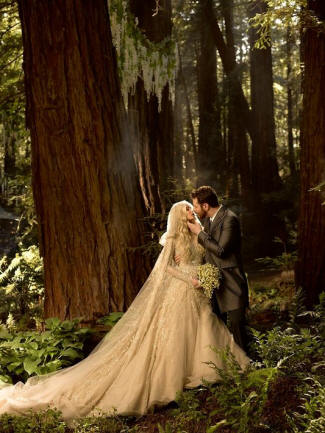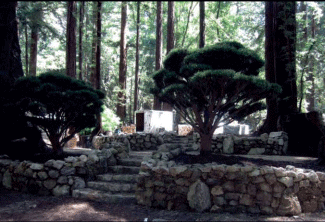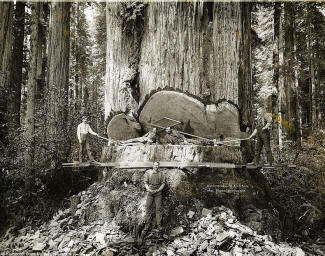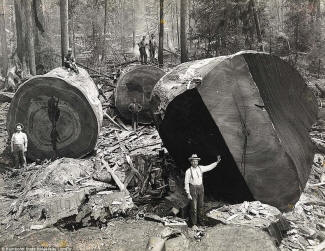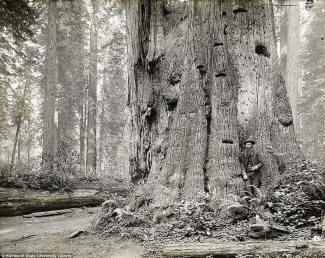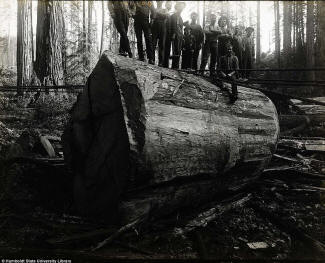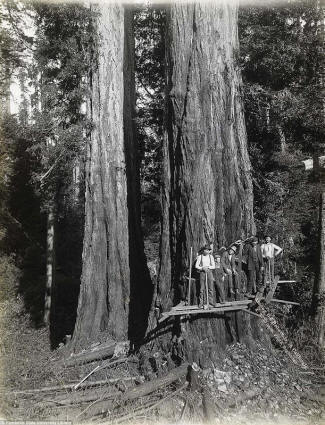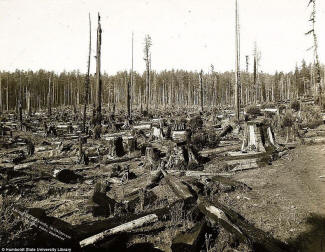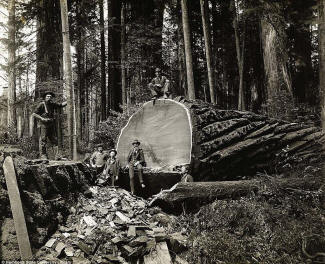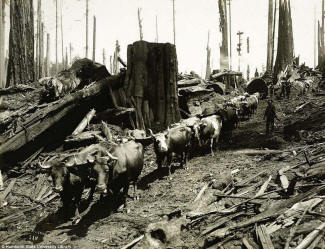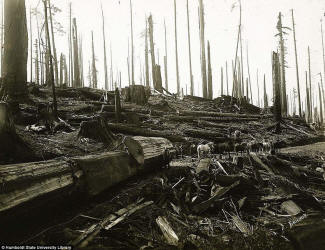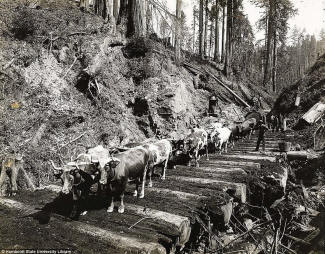Read this letter. It may not change your mind about Sean Parker, but it adds some important details about the nature of the construction at the site.
by ALEXIS C. MADRIGAL
JUN 6, 2013
NOTICE: THIS WORK MAY BE PROTECTED BY COPYRIGHT
YOU ARE REQUIRED TO READ THE COPYRIGHT NOTICE AT THIS LINK BEFORE YOU READ THE FOLLOWING WORK, THAT IS AVAILABLE SOLELY FOR PRIVATE STUDY, SCHOLARSHIP OR RESEARCH PURSUANT TO 17 U.S.C. SECTION 107 AND 108. IN THE EVENT THAT THE LIBRARY DETERMINES THAT UNLAWFUL COPYING OF THIS WORK HAS OCCURRED, THE LIBRARY HAS THE RIGHT TO BLOCK THE I.P. ADDRESS AT WHICH THE UNLAWFUL COPYING APPEARED TO HAVE OCCURRED. THANK YOU FOR RESPECTING THE RIGHTS OF COPYRIGHT OWNERS.
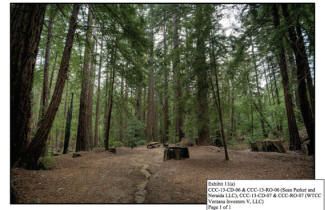
Earlier this week, I wrote about a report that the California Coastal Commission released about its interactions with Sean Parker over his wedding in a Redwood grove in Big Sur. From the language and photographs in the report, I came to some pretty harsh conclusions about the whole affair.
After the post was published, Parker wrote to me with a spirited defense of the wedding. He provided some details, which have reduced the boiling of my blood to a simmer. His whole email is reprinted below, but these are the key new facts, as I see them. One, Parker "consulted informally" with the Save the Redwoods League early in the process, so he wasn't building blindly. Two, according to Parker, the photograph of the gorgeous grove that was included in the CCC report as a "before" photograph was actually taken after Parker's crew had cleaned it up and gotten rid of a lot of the asphalt that had been laid down at the site. Three, his payment of $2.5 million was voluntary and "consistent with the kind of conservation work I'm already doing."
I attempted to reach the CCC to confirm these details, but have not heard back. You can read the staff report they issued here [pdf].
I can't say I agree that there is nothing extravagant about doing $4.5 million in site preparation, but I can say that at least it wasn't quite the know-nothing bigfooting that it appeared to be. Like I said in my original post, I don't really care that rich people spend insane amounts of money on their weddings; I just don't want everyone and everything else to get trampled along the way.
In retrospect, the Nixon administration's extraordinary campaign to undermine the credibility of the press succeeded to a remarkable extent, despite all the post-Watergate posturing in our profession. It succeeded in large part because of our own obvious shortcomings. The hard and simple fact is that our reporting has not been good enough. It was not good enough in the Nixon years, it got worse in the Reagan years, and it is no better now. We are arrogant. We have failed to open up our own institutions in the media to the same kind of scrutiny that we demand of other powerful institutions in the society. We are no more forthcoming or gracious in acknowledging error or misjudgment than the congressional miscreants and bureaucratic felons we spend so much time scrutinizing.
The greatest felony in the news business today (as Woodward recently observed) is to be behind, or to miss, a major story; or more precisely, to seem behind, or to seem in danger of missing, a major story. So speed and quantity substitute for thoroughness and quality, for accuracy and context. The pressure to compete, the fear that somebody else will make the splash first, creates a frenzied environment in which a blizzard of information is presented and serious questions may not be raised; and even in those fortunate instances in which such questions are raised (as happened after some of the egregious stories about the Clinton family), no one has done the weeks and months of work to sort it all out and to answer them properly.
Reporting is not stenography. It is the best obtainable version of the truth. The really significant trends in journalism have not been toward a commitment to the best and the most complex obtainable version of the truth, not toward building a new journalism based on serious, thoughtful reporting. Those are certainly not the priorities that jump out at the reader or the viewer from Page One or "Page Six" of most of our newspapers; and not what a viewer gets when he turns on the 11 o'clock local news or, too often, even network news productions.
"All right, was it really the best sex you ever had?" Those were the words of Diane Sawyer, in an interview of Marla Maples on "Prime Time Live," a broadcast of ABC News (where "more Americans get their news from ... than any other source"). Those words marked a new low (out of which Sawyer herself has been busily climbing). For more than fifteen years we have been moving away from real journalism toward the creation of a sleazoid info-tainment culture in which the lines between Oprah and Phil and Geraldo and Diane and even Ted, between the New York Post and Newsday, are too often indistinguishable. In this new culture of journalistic titillation, we teach our readers and our viewers that the trivial is significant, that the lurid and the loopy are more important than real news. We do not serve our readers and viewers, we pander to them. And we condescend to them, giving them what we think they want and what we calculate will sell and boost ratings and readership. Many of them, sadly, seem to justify our condescension, and to kindle at the trash. Still, it is the role of journalists to challenge people, not merely to amuse them.
We are in the process of creating, in sum, what deserves to be called the idiot culture. Not an idiot subculture, which every society has bubbling beneath the surface and which can provide harmless fun; but the culture itself. For the first time in our history the weird and the stupid and the coarse are becoming our cultural norm, even our cultural ideal. Last month in New York we witnessed a primary election in which "Donahue," "Imus in the Morning," and the disgraceful coverage of the New York Daily News and the New York Post eclipsed The New York Times, The Washington Post, the network news divisions, and the serious and experienced political reporters on the beat. Even The New York Times has been reduced to naming the rape victim in the Willie Smith case; to putting Kitty Kelley on the front page as a news story; to parlaying polls as if they were policies.
I do not mean to attack popular culture. Good journalism is popular culture, but popular culture that stretches and informs its consumers rather than that which appeals to the ever descending lowest common denominator. If, by popular culture, we mean expressions of thought or feeling that require no work of those who consume them, then decent popular journalism is finished. What is happening today, unfortunately, is that the lowest form of popular culture—lack of information, misinformation, disinformation, and a contempt for the truth or the reality of most people's lives—has overrun real journalism.
Today ordinary Americans are being stuffed with garbage: by Donahue-Geraldo-Oprah freak shows (cross-dressing in the marketplace; skinheads at your corner luncheonette; pop psychologists rhapsodizing over the airways about the minds of serial killers and sex offenders); by the Maury Povich news; by "Hard Copy"; by Howard Stern; by local newscasts that do special segments devoted to hyping hype. Last month, in supposedly sophisticated New York, the country's biggest media market, there ran a craven five-part series on the 11 o'clock news called "Where Do They Get Those People ...?," a special report on where Geraldo and Oprah and Donahue get their freaks (the promo for the series featured Donahue interviewing a diapered man with a pacifier in his mouth).
The point is not only that this is trash journalism. That much is obvious. It is also essential to note that this was on an NBC-owned and -operated station. And who distributes Geraldo? The Tribune Company of Chicago. Who owns the stations on which these cross-dressers and transsexuals and skinheads and lawyers for serial killers get to strut their stuff? The networks, the Washington Post Company, dozens of major newspapers that also own television stations, Times-Mirror and the New York Times Company, among others. And last month Ivana Trump, perhaps the single greatest creation of the idiot culture, a tabloid artifact if ever there was one, appeared on the cover of Vanity Fair. On the cover, that is, of Conde Nast's flagship magazine, the same Conde Nast/Newhouse/Random House whose executives will yield to nobody in their solemnity about their profession, who will tell you long into the night how seriously in touch with American culture they are, how serious they are about the truth.
Look, too, at what is on The New York Times best-seller list these days. Double Cross: The Explosive Inside Story of the Mobster Who Controlled America by Sam and Chuck Giancana, Warner Books, $22.95. (Don't forget that $22.95.) This book is a fantasy pretty much from cover to cover. It is riddled with inventions and lies, with conspiracies that never happened, with misinformation and disinformation, all designed to line somebody's pockets and satisfy the twisted egos of some fame-hungry relatives of a mobster. But this book has been published by Warner Books, part of Time Warner, a conglomerate I've been associated with for a long time. (All the President's Men is a Warner Bros. movie, the paperback of All the President's Men was also published by Warner Books, and I've just finished two years as a correspondent and contributor at Time.) Surely the publisher of Time has no business publishing a book, that its executives and its editors know is a historical hoax, with no redeeming value except financial.
By now the defenders of the institutions that I am attacking will have cried the First Amendment. But this is not about the First Amendment, or about free expression. In a free country, we are free for trash, too. But the fact that trash will always find an outlet does not mean that we should always furnish it with an outlet. And the great information conglomerates of this country are now in the trash business. We all know pornography when we see it, and of course it has a right to exist. But we do not all have to be porn publishers; and there is hardly a major media company in America that has not dipped its toe into the social and political equivalent of the porn business in the last fifteen years.
Many, indeed, are now waist-deep in the big muddy. Take Donahue. Eighteen years ago Woodward and I went to Ohio on our book tour because we were told that there was a guy doing a syndicated talk show there who was the most substantive interview in the business. And he was. Donahue had read our book. He had charts, he knew the evidence, he conducted a serious discussion about the implications of Watergate for the country and for the media. Last month, however, Donahue put Bill Clinton on his show—and for half an hour engaged in a mud wrestling contest that was even too much for the studio audience. Donahue was among those interviewed for that WNBC special report about "Where Do They Get Those People ...?," and on that report he uttered a damning extenuation to the effect that as Oprah and the others get farther out there, he too has to do it.
Yes, we have always had a sensational, popular, yellow tabloid press; and we have always had gossip columns, even powerful ones like Hedda Hopper's and Walter Winchell's. But never before have we had anything like today's situation in which supposedly serious people—I mean the so-called intellectual and social elites of this country—live and die by (and actually believe!) these columns and these shows and millions more rely upon them for their primary source of information. Liz Smith, Newsday's gossip columnist and the best of a bad lot, has admitted blithely on more than a few occasions that she doesn't try very hard to check the accuracy of many of her items, or even give the subjects of her column the opportunity to comment on what is being said about them.
For the eight years of the Reagan presidency, the press failed to comprehend that Reagan was a real leader—however asleep at the switch he might have seemed, however shallow his intellect. No leader since FDR so changed the American landscape or saw his vision of the country and the world so thoroughly implanted. But in the Reagan years we in the press rarely went outside Washington to look at the relationship between policy and legislation and judicial appointments to see how the administration's policies were affecting the people—the children and the adults and the institutions of America: in education, in the workplace, in the courts, in the black community, in the family paycheck. In our ridicule of Reagan's rhetoric about the "evil empire," we failed to make the connection between Reagan's policies and the willingness of Gorbachev to loosen the vise of communism. Now the record is slowly becoming known. We have, in fact, missed most of the great stories of our generation, from Iran-contra to the savings and loan debacle.
The failures of the press have contributed immensely to the emergence of a talk-show nation, in which public discourse is reduced to ranting and raving and posturing. We now have a mainstream press whose news agenda is increasingly influenced by this netherworld. On the day that Nelson Mandela returned to Soweto and the allies of World War II agreed to the unification of Germany, the front pages of many "responsible" newspapers were devoted to the divorce of Donald and Ivana Trump.
-- The Idiot Culture, by Carl Bernstein
Here's a lightly edited version of the email that Parker sent me presenting his side of the story.
Alexis,
I read your article with a great deal of sadness and dismay.
First and foremost is that nobody goes out of their way to get married in a redwood forest unless they really love redwood forests. Getting married beneath an old growth redwood tree has been a dream shared by me and my wife for a long time. We spent two years hiking redwood groves, both public and private, in order to locate the perfect spot for our wedding. We needed to find private land that had been previously developed ("disturbed land" in CCC vernacular) so that there would be minimal environmental impact. When we found the Ventana campground site it was not exactly in pristine shape -- the natural ground cover was gone and it had been paved over with black asphalt! The pictures in the CCC report probably show what the site looked like after I removed (or covered) all the black asphalt (which I found appalling) using either bulldozers or just by spreading dirt and forest brush around the area. It is also possible that this area had been cleared as a camping "pad" for an RV or mobile home. Regardless, an undisturbed forest would not be dirt or asphalt, it would be covered in vegetation of some sort.
Second, my foundation has only two primary missions, one is cancer research (specifically cancer immunotherapy), and the other is conservation. I have begun a program of "conservation buying" - that is where I locate private land that needs to be protected, buy it with my own funds, and then donate it to someone like state parks or non-profits to maintain it for the public benefit. I spend quite a bit of my foundation's money on conservation related projects. To that end, I had previously been a major donor to the Save the Redwoods League.
I needed help finding a forest to host the event. Finding a forest with some old growth redwood trees that can accommodate 300 people is no easy task. I enlisted the help of Save the Redwoods to identify the site, and they suggested the Ventana campground precisely because it was private property and not public land, and it was owned and operated by a hospitality business (a hotel) and had previously been used for events. You mention that I "privatized the previously public." There is no sense is which this was public land. The only issue with the campground was that it had been closed to campers for several years due to fire and other issues. The Ventana has an active contractual obligation with the CCC to keep the campground open on a for-profit basis. Given that I was just renting the (already closed) campground for a short time, I could not have possibly known about this issue, and my wedding did not prolong the closure of the campground in any way.
The Save the Redwoods League actually consulted informally on the project from Day 1, sending their Director of Science down to the site to educate our naturalist regarding a plan for work that would be minimally environmentally disruptive to the local redwood and riparian habitats. This is something I chose to do entirely of my own volition and without any pressure from government agencies. (This took place winter of last year.) At this point we had no issues with the CCC or any other agency, I just wanted everything to be as authentic as possible and I didn't want to disrupt the natural habitat. I only knew to do this because I had an existing understanding of forest restoration via my conservation work and I also have an appreciation for what a natural redwood forest should look like because of my time spent hiking around redwood forests. We want to crazy lengths to ensure that nothing in the forest was harmed during the construction process. We used fabric liners to protect the ground from our landscaping work. We avoided planting directly in the soil, instead we brought in potted plants. Contrary to media reports, no redwood trees were harmed by the wedding or construction. (At least none that I'm aware of.)
While we made some mistakes, by and large the biologists who were sent out to the site (by the CCC and others) were happy with the measures we'd taken. Of course it's impossible to get everything exactly right at a production of this scale. Keep in mind when we found it, the campground was full of black asphalt roads, picnic tables, and all kinds of other man-made structures.
Everything we built was designed to be dismantled and removed after the wedding. I inquired about the need for permits early in the process and was informed that, due to the temporary nature of the construction, no such permit would be required. The CCC and Monterey County both offer some sort of exemptions for temporary events. Almost all the structures you see were designed to be temporary--they were actually built off-site and then reassembled on the topsoil of the campground. There is no mortar inside them, so they will just come apart like legos and get carried off. My original agreement with Ventana provided for me to restore the property to the condition in which I had found it, which was anything but perfect. The campground was missing all the normal sorrel leaf ground cover and other foliage. All the the greenery that you see in my photographs had to be brought in by me since the campground had been totally stripped of any vegetation when I found it. My goal was to leave the property in much better condition than when I found it.
More importantly, because I was just renting the site from a hotel, my representatives were told by relevant agencies, such as the CCC and Monterey County planning commission, that it was the responsibility of the property owner, not the hotel guest, to obtain any necessary permits.
How can a hotel guest paying a hotel to host their wedding be in a position to legally apply for permits covering a property that they do not own? There was neither an obligation, contractual or otherwise, nor any legal way for me to apply for permits.
You should also be aware that the $2.5 million was not, strictly speaking, a "fine" for any particular violation. We conceded to pay a $1 million into the CCC's conservation fund, and then work together to deploy a minimum of an additional $1.5 million in charitable contributions to help the Monterey/Big Sur area. This is all work that is consistent with the kind of conservation work I'm already doing. We have some great ideas about how to provide affordable (read: free) camping by bussing under-privileged kids and other groups into the Big Sur area for a free camping experience that they would get to have otherwise. Keep in mind, this is a minimum contribution, I am open to giving much more as the conservation projects develop.
The vision behind this wedding was to integrate with nature as much as possible, to bring out the natural beauty of the site while incorporating the kinds of things that one would need at a wedding. We did as much landscaping as possible using native species (ferns, sorrel ground cover, forget-me-not flowers), and everything was placed in potted plants with mulch around them so as not to plant or introduce foreign species into the forest. We used no invasive species.
There were no "ruined castles" built in the forest. The only stonework were walkways for the guests and walls that served as barriers between the different areas. I don't know where all this talk of castles and towers and things came from. The stonework is actually hollow (filled with bird wire) so that it can be removed quickly.
We had a very specific aesthetic vision for this event that was subtle, tasteful, and carefully orchestrated. Everything we did was an homage to nature, to the natural redwood environment which I call "God's cathedral." We wanted the forest to speak for itself, but we had to build the basic minimum features to make the campground safe and viable for a wedding.
Finally, you mention that what we did was "extravagant" yet none of the usual tasteless crap that rich people do at their weddings was present here -- no ice sculptures, no caviar, no pop stars hired to sing their hits songs, etc. This is why your article and so many other articles have been so deeply offensive. Maybe I will be allowed to release some photos of the event at some point so you can see first hand what we created rather than just speculating based on what else has been published in the press. All of the numbers that have been released were total fabrications (this $9 million number of instance) and are WAY off base. I will say, against my better instinct to tell you, that we spent roughly $4.5 million on prepping the site and big part of that was restoring the forest floor (I should say, covering the forest floor with plants) since it had been paved over in black asphalt or cleared by bulldozers before we ever laid eyes on the campground.
best,
sp

